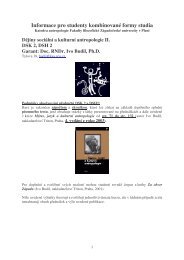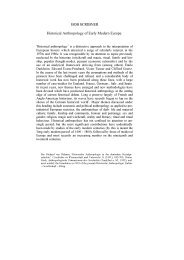The Revival of Narrative: Reflections on a New Old History ...
The Revival of Narrative: Reflections on a New Old History ...
The Revival of Narrative: Reflections on a New Old History ...
You also want an ePaper? Increase the reach of your titles
YUMPU automatically turns print PDFs into web optimized ePapers that Google loves.
THE REVIVAL OF NARRATIVEI Iexcepti<strong>on</strong>s to the rule. <str<strong>on</strong>g>The</str<strong>on</strong>g>se procedures have undoubtedly improvedthe logical power and persuasiveness <str<strong>on</strong>g>of</str<strong>on</strong>g> historical argument. Nor isthere any disagreement that whenever it is appropriate, fruitful andpossible from the surviving records, the historian should count.<str<strong>on</strong>g>The</str<strong>on</strong>g>re is, however, a difference in kind between the artisan quantificati<strong>on</strong>d<strong>on</strong>e by a single researcher totting up figures <strong>on</strong> a handcalculatorand producing simple tables and percentages, and the work<str<strong>on</strong>g>of</str<strong>on</strong>g> the cliometricians. <str<strong>on</strong>g>The</str<strong>on</strong>g> latter specialize in the assembling <str<strong>on</strong>g>of</str<strong>on</strong>g> vastquantities <str<strong>on</strong>g>of</str<strong>on</strong>g> data by teams <str<strong>on</strong>g>of</str<strong>on</strong>g> assistants, the use <str<strong>on</strong>g>of</str<strong>on</strong>g> the electr<strong>on</strong>ic computerto process it all, and the applicati<strong>on</strong> <str<strong>on</strong>g>of</str<strong>on</strong>g> highly sophisticatedmathematical procedures to the results obtained. Doubts have beencast <strong>on</strong> all stages <str<strong>on</strong>g>of</str<strong>on</strong>g> this procedure. Many questi<strong>on</strong> whether historicaldata are ever sufficiently reliable to warrant such procedures; whetherteams <str<strong>on</strong>g>of</str<strong>on</strong>g> assistants can be trusted to apply uniform coding proceduresto large quantities <str<strong>on</strong>g>of</str<strong>on</strong>g> <str<strong>on</strong>g>of</str<strong>on</strong>g>ten widely diverse and even ambiguous documents;whether much crucial detail is not lost in the coding procedure;if it is ever possible to be c<strong>on</strong>fident that all coding and programmingerrors have been eliminated; and whether the sophisticati<strong>on</strong> <str<strong>on</strong>g>of</str<strong>on</strong>g> themathematical and algebraic formulae are not ultimately self-defeatingsince they baffle most historians. Finally, many are disturbed by thevirtual impossibility <str<strong>on</strong>g>of</str<strong>on</strong>g> checking up <strong>on</strong> the reliability <str<strong>on</strong>g>of</str<strong>on</strong>g> the finalresults, since they must depend not <strong>on</strong> published footnotes but <strong>on</strong>privately owned computer-tapes, in turn the result <str<strong>on</strong>g>of</str<strong>on</strong>g> thousands <str<strong>on</strong>g>of</str<strong>on</strong>g>privately owned code-sheets, in turn abstracted from the raw data.<str<strong>on</strong>g>The</str<strong>on</strong>g>se questi<strong>on</strong>s are real and will not go away. We all know <str<strong>on</strong>g>of</str<strong>on</strong>g>doctoral dissertati<strong>on</strong>s or printed papers or m<strong>on</strong>ographs which haveused the most sophisticated techniques either to prove the obvious orto claim to prove the implausible, using formulae and language whichrender the methodology unverifiable to the ordinary historian. <str<strong>on</strong>g>The</str<strong>on</strong>g>results sometimes combine the vices <str<strong>on</strong>g>of</str<strong>on</strong>g> unreadability and triviality. Weall know <str<strong>on</strong>g>of</str<strong>on</strong>g> the doctoral dissertati<strong>on</strong>s which languish unfinished sincethe researcher has been unable to keep under intellectual c<strong>on</strong>trol thesheer volume <str<strong>on</strong>g>of</str<strong>on</strong>g> print-out spewed out by the computer, or has spent somuch effort preparing the data for the machine that his time, patienceand m<strong>on</strong>ey have run out. One clear c<strong>on</strong>clusi<strong>on</strong> is surely that, wheneverpossible, sampling by hand is preferable and quicker than, and just asreliable as, running the whole universe through a machine. We allknow <str<strong>on</strong>g>of</str<strong>on</strong>g> projects in which a logical flaw in the argument or a failure touse plain comm<strong>on</strong> sense has vitiated or cast in doubt many <str<strong>on</strong>g>of</str<strong>on</strong>g> the c<strong>on</strong>clusi<strong>on</strong>s.We all know <str<strong>on</strong>g>of</str<strong>on</strong>g> other projects in which the failure to record<strong>on</strong>e piece <str<strong>on</strong>g>of</str<strong>on</strong>g> informati<strong>on</strong> at the coding stage has led to the loss <str<strong>on</strong>g>of</str<strong>on</strong>g> animportant result. We all know <str<strong>on</strong>g>of</str<strong>on</strong>g> others where the sources <str<strong>on</strong>g>of</str<strong>on</strong>g> informati<strong>on</strong>are themselves so unreliable that we can be sure that little c<strong>on</strong>fidencecan be placed in the c<strong>on</strong>clusi<strong>on</strong>s based <strong>on</strong> their quantitativemanipulati<strong>on</strong>. Parish registers are a classic example, up<strong>on</strong> which a







